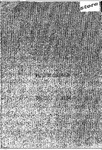THE DETERMINATION OF TRACE METALS IN SEA WATER USING ICP-MS
| dc.contributor.author | BLOXHAM, MARTIN JOHN | |
| dc.contributor.other | School of Geography, Earth and Environmental Sciences | en_US |
| dc.date.accessioned | 2012-08-02T08:54:22Z | |
| dc.date.available | 2012-08-02T08:54:22Z | |
| dc.date.issued | 1994 | |
| dc.identifier | Not available | en_US |
| dc.identifier.uri | http://hdl.handle.net/10026.1/1073 | |
| dc.description.abstract |
Inductively coupled plasma-mass spectrometry (ICP-MS) offers exceptional sensitivity and multi-element capability for trace metal analysis but the formation of polyatomic ions (particularly below m/z = 80) can cause, serious interferences. Such species can be introduced via precursor atoms in atmospheric gases, the sample matrix or impurities in the argon support gas. This thesis describes the development of a portfolio of analytical methods coupled with ICP-MS detection for the determination of trace metals such as manganese, cobalt, copper, nickel, zinc, mercury and lead in complex matrices such as sea water. A literature review of coupled techniques is given in Chapter one. Chapter two discusses the effect of sea water on the analytical performance of ICP-MS. Initial studies were carried out using a single channel flow injection (FI) manifold and included an investigation of the addition of nitrogen to the nebulizer gas flow of the ICPMS for the reduction of the ArNa* polyatomic ion interference at m/z = 63 on the Cu signal. This was followed by a multivariate simplex optimisation for the suppression of the ArNa* polyatomic ion interference at m/z = 63 and non-spectroscopic interferences affecting other masses in sea water, for the determination of Cu, Cr, Mn, Ni, Co, Zn and Pb. In Chapter three an on-line FI-ICP-MS matrix elimination method for the determination of trace metals such as Mn, Co, Cu, Zn and Pb in sea water is discussed. The method involved chelation of the analytes onto Chelex-100 or MetPac CC-1 iminodiacetate (IDA) .resin, with the simultaneous removal of indirectly interfering matrix species, particularly Na and CI ions. Results showing how the effects of the interferences were overcome, together with validation of the method by the analysis of open ocean, coastal and estuarine certified reference materials are reported. s Chapter four compares FI approaches coupled with AFS, ICP-AES and ICP-MS detectors for the determination of total mercury. Initial studies compared figures of merit for FI (conventional pneumatic nebulization) and Fl-cold vapour generation (CVG) coupled with ICP-AES and ICP-MS. Detection limits for total Hg were improved by developing simple on- and off-line preconcentration procedures using a MetPac CC-1 micro-column incorporated in a FI manifold vAth conventional pneumatic nebulization. An AFS detector was then used in the development of a method for the determination of total mercury with an on-line bromide/bromate oxidation step. In chapter five an LC-ICP-MS method for the speciation of Hg in sea water samples is described. The method involved the separation of mercury(II) chloride, methylmercury chloride and ethylmercury chloride on a Cig ODS stationary phase with an ammonium acetate/acetonitriIe/2-mercaptoethanol mobile phase. In order to achieve the necessary detection limits required for the determination of mercury in real sea water samples (< 50 ng r^), an off-line preconcentration method using a dithiocarbamate resin was used. | en_US |
| dc.description.sponsorship | Department of Environmental Sciences; Thornton Research Centre, Shell Research Limited, Chester | en_US |
| dc.language.iso | en | en_US |
| dc.publisher | University of Plymouth | en_US |
| dc.title | THE DETERMINATION OF TRACE METALS IN SEA WATER USING ICP-MS | en_US |
| dc.type | Thesis | |
| dc.identifier.doi | http://dx.doi.org/10.24382/3271 | |
| dc.identifier.doi | http://dx.doi.org/10.24382/3271 |
Files in this item
This item appears in the following Collection(s)
-
01 Research Theses Main Collection
Research Theses Main


